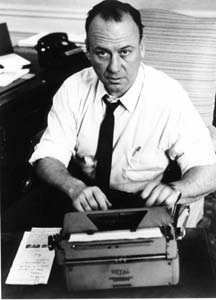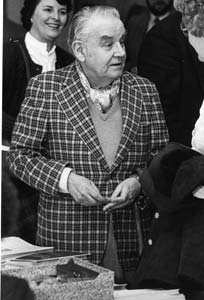
1945 – Barney Kilgore is named president of Dow Jones & Co.
The newspaper, if it were to survive the lean years after the crash, needed to change its focus. And a young journalist named Barney Kilgore was the person to handle the task. Kilgore had been hired to work at The Journal directly out of DePauw University in 1929, and after a few months in New York was moved to the San Francisco office. He immediately gained a reputation for the thoroughness of his reporting, primarily because he checked what banks were reporting for their profits in their press releases with what was reported in their audited statements and noticed some large discrepancies. Kilgore returned to New York after writing the newspaper’s first front-page feature story and was assigned to write the story about the newspaper’s reporters taking bribes. In 1935, he went to run the Washington bureau, where he developed a popular feature called “The Washington Wire.” His fame grew when President Franklin Roosevelt, at a press conference, told other reporters to read Kilgore’s stories if they wanted to understand part of his New Deal policies. By 1941, Kilgore was back in New York and running the newspaper as managing editor. Barron’s descendants, who had thought about shutting the paper to stem its losses, listened and agreed with Kilgore’s radical plan to save the newspaper whose name reminded everyone of what had caused the Great Depression.

Kilgore, along with editor Casey Hogate, wanted to make the newspaper the first to be delivered across the country, transmitted the newspaper’s pages by new technology. To make the newspaper appeal to readers across the United States , Kilgore decided to radically change the content of the newspaper. It would no longer be “The newspaper for the investor,” as its slogan developed in 1903 noted. The Journal would be a mainstream newspaper that specialized in news about business and finance but also included news and information that anyone would want. A 1978 Dow Jones executive committee report noted that Kilgore’s long-range plan to overhaul the newspaper was the first in the company’s history and “was based on the belief that never again in the foreseeable future would the financial industry provide the type of market which would support a first-class daily newspaper.”
“Barney would talk of how The Journal ought to be – and could be – a national newspaper,” said Vermont Royster, who worked with Kilgore in the Washington bureau and became editor of the paper in 1958. “Business, he said, and the political affairs that affected it, was the one topic of as vital interest to the reader in Omaha as the reader in New York . Why not give each the same important news each day? It was a fantasy, so most of his colleagues thought.” Royster was not all that impressed with the idea.